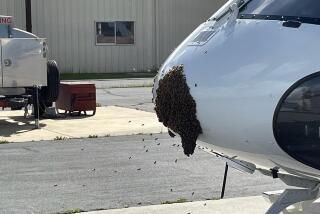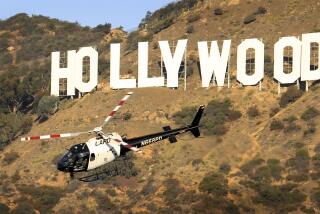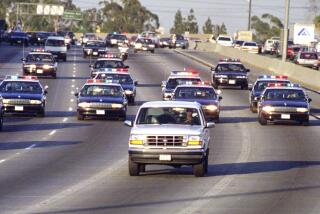Bear in the Air : Airborne State Trooper Uses High-Tech Perch to Put Brakes on Speeders : Washington: Digital watches calculate the elapsed time and speed of vehicles passing highway markers. Then he calls in the surface-based enforcers. Few violators fight citations.
- Share via
MOUNT VERNON, Wash. — Even the most sophisticated radar detectors won’t spot State Patrol Trooper Joe Anderson--nicknamed by truckers as the “Bear in the Air.”
Anderson flies his Cessna 182 in slow circles 1,500 feet over Interstate 5. At that height, it’s easy to spot speeders.
“The view is fantastic. You can see for miles,” Anderson said. “And the fast ones just jump out at you.”
But Anderson doesn’t rely on dead reckoning to determine speed. He uses twin digital Robic Autotrak watches that calculate the elapsed time and speed made by vehicles passing highway markers spaced one-half mile apart.
“If it’s accurate enough to determine a world record, it ought to be accurate enough to determine how fast a car’s going,” he said.
The State Patrol has used aerial reconnaissance since the mid-1960s. Today five planes, purchased through federal grants, patrol state highways. Two are based in Yakima and the others in Olympia. They also are used in medical emergencies.
Of the 18,000 traffic violators he’s spotted from the air, Anderson has been called to appear in court just 15 times to defend his role. The courts accept the procedures used by flying troopers, he said.
Anderson flies between Blaine and Vancouver, Wash., on a randomly selected schedule set up with the local State Patrol detachments.
A recent flight over Skagit County took Anderson on a wide swath over I-5, where he spotted five speeders during one hour in the northbound lanes. Usually the tally is higher, he said, but slick roads made drivers more cautious.
Three troopers sat in their idling cars atop the Conway I-5 on-ramp, waiting to hear from Anderson. When given word, they swooped onto the freeway and pulled over the offenders.
“The troopers aren’t using radar because it sets off detectors,” Anderson explained. “That’s why we’re doing it all from up here.”
Road Trooper Jeffrey Marken said he has seen some people place their radar detectors facing up, in a fruitless attempt to track the planes.
“But the pilots don’t use radar guns. There’s not much to track,” he said.
Anderson scans the traffic while keeping an eye on the plane’s controls. “The plane pretty much flies itself,” he said.
“Pilots who are pulled over by troopers always bring up the issue, ‘How can you be monitoring traffic while flying the plane?’ Well, you do it every day and you get pretty good at it,” he said.
Anderson, 40, has been a state trooper half his life. He’s been a pilot for 11 years, the last three full time.
He glanced down at a vehicle shooting rooster tails on the wet freeway--foggy plumes thrown up behind a fast-moving vehicle--and readied his stopwatch. The vehicle, apparently unaware of the “Bear in the Air,” sped past a freeway marker painted on the side of the road and the countdown began.
The vehicle passed a second roadside marker a half-mile from the first. Anderson’s stopwatch, calibrated for time and miles per hour, clocked the driver at 73 m.p.h.. A second check 30 seconds later showed him slowing to 71.
“We’ll go for two or three checks before the trooper stops them,” Anderson said. “It’s not uncommon for a person to say, ‘I’ve only been going 65,’ but the trooper then can say, ‘Yeah, but for the past 1 1/2 miles you’ve been going 80.’ ”
The program has proven invaluable, Burlington-based Trooper Floyd Gregg said.
“We can concentrate all our efforts in one area where we normally can’t patrol efficiently, like the long stretches of I-5,” Gregg said.
“The beauty of it is that we can catch the professional speeders who know where we work and how we work,” Gregg said. “Those drivers have developed a system where they know when to slow up and when to go, and the aircraft defeats a lot of that.”
But aerial patrols seem more effective stopping speeding cars than trucks, Gregg said.
“Truck drivers have their own communication system and if you listen to them talk, they know about the ‘Bear in the Air,’ ” Floyd said. “Obviously, some of them have been stung a few times.”
More to Read
Sign up for Essential California
The most important California stories and recommendations in your inbox every morning.
You may occasionally receive promotional content from the Los Angeles Times.










